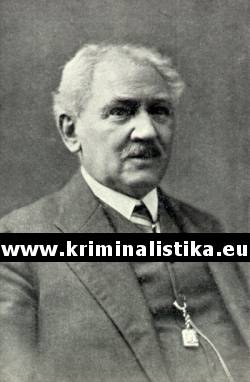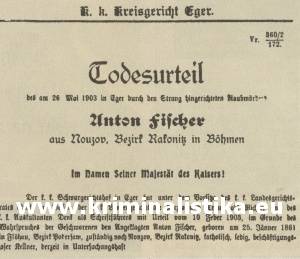Leopold Wohlschlager
Austro-Hungarian and Czechoslovakian executioner
Born in Osijek, Croatia, 1855 – died in Prague, 1929

Leopold Wohlschlager was one of the five executioners during the Austo-Hungarian period in the history of Bohemia. He had his place of business in Bohemia, the rest of them were in Wienna, Budapest, Osijek (Croatia) and Graz. After 1918, he became the Official State Executioner in the then Czechoslovakia. He dealt with the execution of twenty-four people during his life.
Leopold Wohlschalger's father is a inn-keeper in Osijek. When Leopold is 6, his father dies (he is even said to have been murdered). Leopold's mother marries John Baptist Pippiger a upholsterer from Zagreb. When twenty-seven, the family tradition has it that John Baptist Pippiger becomes the executioner - his father was the executioner in Graz and his older brother is the executioner in Osijek (Pippiger is one of fifteen). In 1865, Pippiger appeals for a transfer to Wienna as the Wiennese executioner has died. But he is transfered to Prague. On November 21st, 1865, the imperial decree proclaims Pippiger the Bohemian Kingdom Supreme Provincial Court Excecutioner.
When fifteen years old, Leopold Wohlschlager (some authors spell Wohlschläger) takes part in his very first execution as his step-father's help-mate. It takes place at the military drill-ground in Plzeň - Bory early in the morning of September 8th, 1871. Jan Janeček, a Gipsy nicknamed Serynek, the twofold murderer and a robber is being executed. He and his twenty-one-man gipsy gang were a bugbear to the whole West-Bohemian region for one year and a half. 15,000 people stand by. The young adept-executioner is supposed to arrange lots of things: to assist in building the scaffold and control its surroundings a day before the execution, to help another co-executioner to drag up the rope with the hanged during the execution and, in the evening, to help to drag down the hanged from the scaffold and to put the body into the grave dug next to the scaffold.
But Leopold, his step-father and some other help-mates have to return to the scaffold at night. A secret court order has it that the Janeček's body, buried by the scaffold, must be exhumed and taken to a completely different place. The authorities learnt that the gipsy gangs settled in the forests near Plzeň intend to steal the body from the grave… The execution described above is said to be the very last public execution in Bohemia. It is not true. In fact, the very last public execution takes place in front of the Pankrác Prison, Prague, on May 22nd, 1946. Thousands of people stand by K. H. Frank, the Nazi, being executed that day…
When taking part in his very first execution, Wohlschlager is an apprentice at master goldsmith Studený in Konviktská Street, the Old Town and lives with his mother and his step-father in Platnéřská Street. John Baptist Pippiger loves his family, does socialize a lot and is said to be good company. He goes to The Black Brewery Pub very often. No one minds being there with the executioner. "The executioner" is written under his name on his front-door. Before the execution itself, he shakes hands with the convict saying: "It is nice to meet you. What a pity we can't enjoy our friendship longer!"…
It is December 6th, 1872. Leopold Wohlschlager's mother dies after a eight-day disease. John Baptist Pippiger is arrested and accused of poisoning his wife. Six days later, she is proved to die after having eaten sick hash-and-crumbs sausages. Pippiger misses the burial as his wife was buried while he was in prison. A crushed man is released from prison after that.
John Baptist Pippiger dies at the age of 50 on January 15th, 1888. A day before his death, in Kutná Hora, he executes the Přenosil brothers, August a Karel, who stabbed to death a police constable who caught them red-handed when they trying to break into a house. He executed fifty criminals for his twenty-three years spent "in justice service"…
Twenty-eight applicants apply for the vacancy. They are of various professions: a butcher, a soldier or several unsuccessfull medical students. The Prague Penal Court enact a thirty-three-year old goldsmith, Leopold Wohlschlager, to become the successor to his dead father on June 24th, 1888 and it is signed by the President of the Supreme Provincial Court in Prague, Rumler von Aichenwehr. The basic salary is 800 gold dollars a year plus 25 gold dollars for every execution.
Leopold Wohlschlager, the Executioner, takes control of his very first execution in the yard of the Provicional Penal Court in Charles Square, Prague, on October 11th, 1895. The convict Antonín Hofmann, a twenty-two-year old miner, shot dead the steel-works inspector Karel Rejt and the overman Kajetán Čermák in Březové Hory near Příbram. He considers them to be "the exploiters"… That murder can be thought to be politically motivated. Antonín Hofmann is known to be a nationally conscious man who critises Rejt very often. Rejt proclaimed himself to be of German nationality. He is known to treat the Czech miners as the second-rate people. Rejt fires Antonín Hofmann and his father from their work. A young Hofmann buys a revolver and shoots Rejt dead in his office. Čermák is shot dead as he has a liking for Rejt. Having shot them dead, Hofmann waits in the office until the police constables come.
The Antonín Hofmann execution is the focus of attention of Bohemian people and raises some riots. There are hundreds of people shouting "Amnesty, amnesty!" in the Charles Square. Hofmann being taken to the scaffold, he swears and chants anti-Austrian slogans. The President of the Supreme Provincial Court orders the present soldiers to start drumming and thus Hofmann's swearing cannot be heard. Before Hofmann gasps his last, he manages to shout out: "Kill the emperor! The emperor must die!"
Crowds of people rush into the yard hoping to get "a souvenir" for that execution. Some of the people even want to get the far-famed "yellow suitcase of the executioner". Wohlschlager has to even fight for saving his suitcase… It takes tens of minutes to force out the people from the yard. It is Wohlschlager's the only and the last politically motivated execution in his career.
Leopold Wohlschlager gets married soon after that execution. He and his wife move to a house in Kaprová Street. The house is just opposite the "The Three Carps Café". He has three daughters and a son. His son dies in WW I. But unlike his step-father, he does not go to pubs or cafés. He has a gentleman effect and hates view of blood. If there is no execution to be exercised, he works a goldsmith in Příčná Street.
There also is a woman to be executed – a thirty-year old Julie Humlová. The execution takes place in the Provincial Penal Court yard, Wienna, on January 2nd, 1900. She murders her only a five-year old bastard daughter Anna. Little Anna was starving and tortured by her mother. Anna succumbs on March 9th, 1899. Humlová has even been sentenced for torturing her child before. As the Wienna executioner Seelinger died in 1899 and the new executioner has not been enacted, it is up to Leopold Wohlschlager. Wohlschlager is even thought to be not only the Bohemian executioner but to become the Austrian executioner too. The execution itself does not run smoothly. Before Hummlová dies, she wince with pain hanging on the scaffold for several minutes. Some representatives of judical power are sick. The executioner Wohlschlager fails. It is because of the Wiennese "tools". He had no opportunity to learn more about it before the execution… And that is why not Leopold Wohlschlager, but a Wiennese coféroom owner Lang is enacted the Wiennese executioner.
The very last execution exercised under the Austro-Hungarian Monarchy takes place in Cheb on May 26th, 1903. It is Wohlschlager's 19th execution. A waiter Antonín Fišer (42) from Nouzov near Rakovník is hanged for the robbery with murder of a inn-keeper Albert Hönisch. Hönisch is the owner of a forest restaurant in Karlovy Vary.
The photograph of Antoním Fišer death sentence

After 1918, Wohlschlager is enacted the State Executioner and his annual wage is Kč 15,000 plus Kč 500 for every execution. Having exercised five more executions, he retires at the age of seventy-four. Ludvík Novák (36) from Malý Bednárec is sentenced to death for murdering two butchers. The execution takes place in Tábor on January 9th, 1923. Fifteen days later, a twenty-six-year old Josef Kolínský from Prague is executed for murdering Josef Ledecký, a watchmaker and a goldsmith, his wife and their daughter Viktora. Kolínský commits the murder together with his younger brother Jan. The then-President T. G. Masaryk changes the Kolínský death sentence into life imprisonment.
Jindřich Bažant (33) from Pardubice is the next executed. He murdered his two lady-loves in the Tatra Mountains, Slovakia. The third lady-love of his is attempted to be murdered. The execution takes place in Kutná Hora on June 26th, 1927. Bažant, weighting only 47 kgs, is the lightest convict in Wohlschlager's career. Bažant refuses to eat before the execution. He even tries to pretend to be an insame person by eating his shirt and several nails…
František Sandtner, a twenty-four-year old soldier, is executed for murdering a farmer Döllner, his wife and their two childern and their maiden. Sandtner uses an axe. It happens in Doyscherhof (not existing any longer) near Mariánské Lázně. The execution takes place in Plzeň. After the murder, Sandtner takes Kč 270 in cash, six eggs and a half a kilo of butter from the farmhouse.
A twenty-seven-year old soldier, "an evasive robber", Martin Lecián from Předměstí near Uherský Ostroh is the last client of Leopold Wohlschlager's. Lecián is accused of committing 104 crimes, including ten acts of murder both perpetrated and imperpetrated. The execution takes place in Olomouc on October 3rd, 1927.
After Lecián's death, a legend comes into being. The legend goes that "the goodluck-charm" (a rope taken from a scaffold) makes Lecián evasive. Lecián is said to have that rope on him even during the execution. But every legend is partly based on a true story. After Lecián's execution, there are placed on deposit of Olomouc Court Museum his jimmies, his murderous weapons and some personal things, his death-mask and - the rope he was hung on. It was Leopold Wohlschlager's twenty-fourth and very last execution. An officer asks the old executioner to get a piece the rope. And thus a lucky visitor to that little museum can see Lecián's belongings placed side by side. Only that piece of the rope did not belong to Lecián - but, who cares nowadays...
Having executed Martin Lecián, Leopold Wohlschlager finishes his career "in justice service". His son-in-law, Nehyba, is enacted to the place of the State Executioner. He was chosen from 200 applicants (a woman was among them too). Seventeen more people are executed until the beginning of the WW II. By the way, the death sentence is quite common at that time. But the then-President T. G. Masaryk changes death sentences into life imprisonments very often. He does so almost 400 times.
In Czechoslovakia, the death sentence is abolished on May 2nd, 1990 after the most extensive amnesty in the history of the country. A great crime wave follows. T. G. Masaryk said that no revolution can be the reason for abolishing the death sentence… Václav Havel repreives 1948 convicts until the end of 2002. Including murderers or bank robbers…
© Miloslav Jedlička, D. C. L.Translated by inspector WO Pavel Vršovský, M. A.